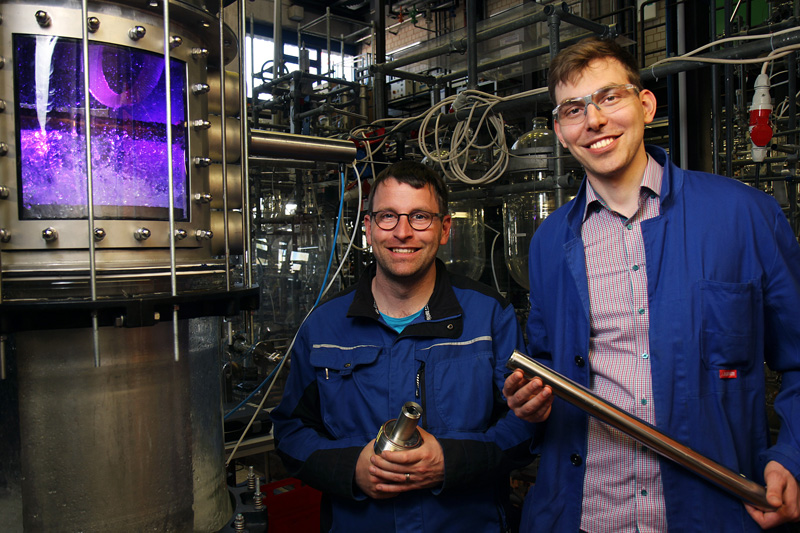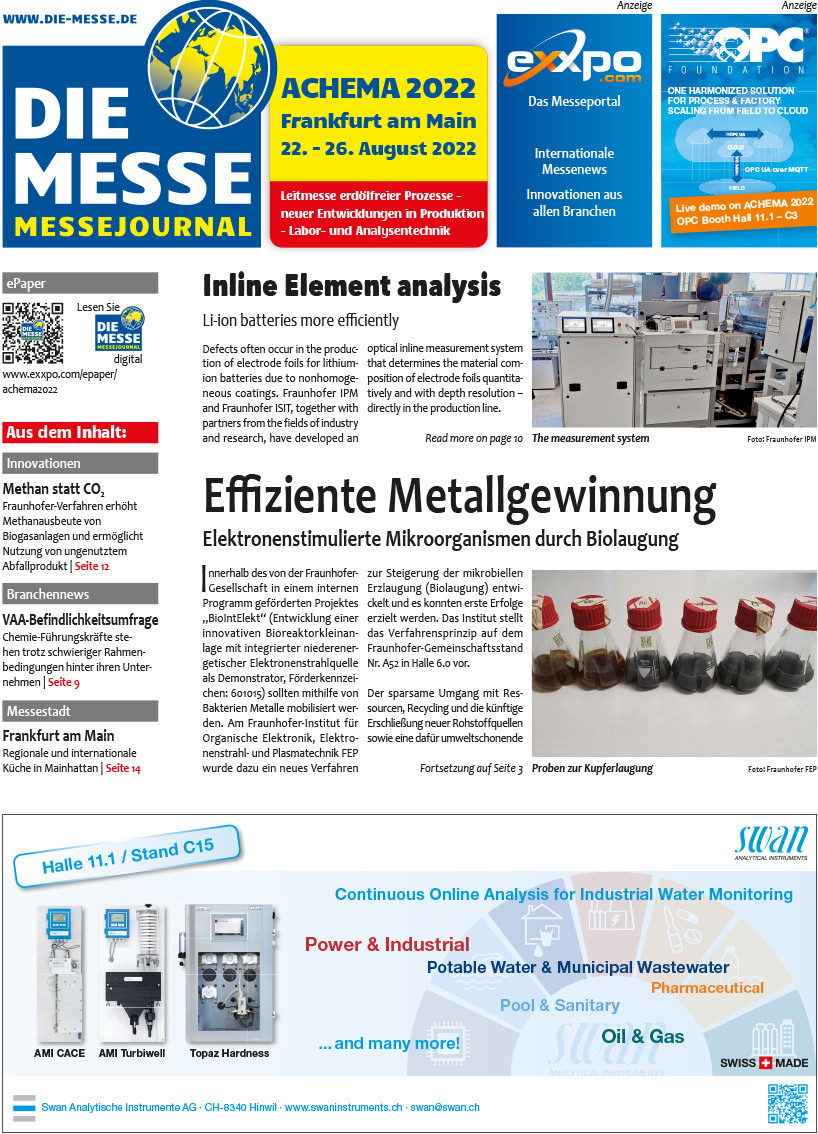11 June 2018
At this year’s ACHEMA, they will be presenting the technology in Hall 9.2, Stand A86a. The camera system measures whether there is a high degree of droplet formation, which can negatively affect the separation of components. In the future, this technology could take countermeasures whenever the relevant measurement data change – and can also save energy.
During distillation, liquids are evaporated and then separated into their constituents following the subsequent condensation of the vapour. A well-known example can be found in the refining of crude oil, where the crude oil is separated into high-boiling heavy oil, diesel and petroleum, as well as into lower-boiling kerosenes or gasolines.
“This common procedure involves a high amount of energy consumption,” says Jonas Schulz, who examines this procedure as part of his doctoral studies at the chair of separation science and technology under Professor Dr. Hans-Jörg Bart. In the United States alone, distillation is responsible for half of the energy costs associated with thermal separation processes in the chemical industry. This incurs costs in excess of USD 100 billion every year.
The engineers at the TUK are developing a technology that will improve energy efficiency in the future. Their approach is based on a camera system that monitors the process. “Distillation in the chemical industry takes place in what are known as ‘fractionating columns’,” explains Markus Lichti, who is also involved in the project. These columns are cylindrical installations that contain a series of distillation plates. These can be configured in a variety of ways, depending on the application, including plates with a sieve-like surface.
Separation occurs as part of a continuous process in which vapour is produced at the very beginning by adding the corresponding mixture into the middle of the column. It runs downwards through the individual plates and is heated in the lower section of the column. It then rises to the top as vapour. Mixture is regularly fed into the system to prevent the reaction from stopping. “In turn, the vapour heats the liquid, which then begins to boil and rise as vapour,” adds Schultz, while explaining the principle. “It then cools again and collects in liquid form on the next highest plate.” As a result, the constituents of the liquid that have a lower boiling point evaporate again and move up to the next distillation plate in the column. This process continues over several levels, until the liquid with the lowest boiling point has accumulated on the highest plate.“Contamination occasionally occurs during distillation, since the liquid does not separate properly into the individual components,” Lichti continues. This can be caused by a range of different factors, such as a distinctly increased vapour flow, excessive pressure or insufficient liquid in the system.
For instance, it is possible for the liquid and vapour to mix on the plate to such a degree that the vapour carries away some of the droplets from the liquid phase. Experts refer to this as entrainment. The droplets move up to the next plate where they remain; in the refining of crude oil, for example, some of the heavy oil can accumulate with the diesel, thereby changing its chemical properties.
The camera system developed by the researchers at Kaiserslautern may provide a solution to this in the future. The camera is integrated into a probe – a stainless-steel tube – which protects it against the hot vapour. The probe is inserted into the fractionating column through an access slot. This access slot resembles the principle of a drawer in which the probe is fixed in place. A glass plate allows the camera to look into the interior of the column. High-contrast images are enabled by means of lighting technology housed in another access slot directly opposite.
https://www.uni-kl.de/
https://www.achema.de/
ACHEMA: New camera system monitors distillation
In order to separate chemical mixtures into their single components, industry operators commonly carry out energy-intensive distillation, such as in crude oil refineries. Researchers at the Technische Universität Kaiserslautern (TUK) are developing a camera system that monitors this process.
 Photo: TUK/Thomas Koziel Photo: TUK/Thomas KozielResearchers Markus Lichti (left) and Jonas Schulz are developing the camera system. |
During distillation, liquids are evaporated and then separated into their constituents following the subsequent condensation of the vapour. A well-known example can be found in the refining of crude oil, where the crude oil is separated into high-boiling heavy oil, diesel and petroleum, as well as into lower-boiling kerosenes or gasolines.
“This common procedure involves a high amount of energy consumption,” says Jonas Schulz, who examines this procedure as part of his doctoral studies at the chair of separation science and technology under Professor Dr. Hans-Jörg Bart. In the United States alone, distillation is responsible for half of the energy costs associated with thermal separation processes in the chemical industry. This incurs costs in excess of USD 100 billion every year.
The engineers at the TUK are developing a technology that will improve energy efficiency in the future. Their approach is based on a camera system that monitors the process. “Distillation in the chemical industry takes place in what are known as ‘fractionating columns’,” explains Markus Lichti, who is also involved in the project. These columns are cylindrical installations that contain a series of distillation plates. These can be configured in a variety of ways, depending on the application, including plates with a sieve-like surface.
Separation occurs as part of a continuous process in which vapour is produced at the very beginning by adding the corresponding mixture into the middle of the column. It runs downwards through the individual plates and is heated in the lower section of the column. It then rises to the top as vapour. Mixture is regularly fed into the system to prevent the reaction from stopping. “In turn, the vapour heats the liquid, which then begins to boil and rise as vapour,” adds Schultz, while explaining the principle. “It then cools again and collects in liquid form on the next highest plate.” As a result, the constituents of the liquid that have a lower boiling point evaporate again and move up to the next distillation plate in the column. This process continues over several levels, until the liquid with the lowest boiling point has accumulated on the highest plate.“Contamination occasionally occurs during distillation, since the liquid does not separate properly into the individual components,” Lichti continues. This can be caused by a range of different factors, such as a distinctly increased vapour flow, excessive pressure or insufficient liquid in the system.
For instance, it is possible for the liquid and vapour to mix on the plate to such a degree that the vapour carries away some of the droplets from the liquid phase. Experts refer to this as entrainment. The droplets move up to the next plate where they remain; in the refining of crude oil, for example, some of the heavy oil can accumulate with the diesel, thereby changing its chemical properties.
The camera system developed by the researchers at Kaiserslautern may provide a solution to this in the future. The camera is integrated into a probe – a stainless-steel tube – which protects it against the hot vapour. The probe is inserted into the fractionating column through an access slot. This access slot resembles the principle of a drawer in which the probe is fixed in place. A glass plate allows the camera to look into the interior of the column. High-contrast images are enabled by means of lighting technology housed in another access slot directly opposite.
https://www.uni-kl.de/
https://www.achema.de/
More news about "ACHEMA":
17 June 2022
ACHEMA 2022 addresses the industry’s key issues digitalisation and sustainability
In addition to the transformation towards a climate-neutral chemical industry and the perennial topic of digitalisation, the current global political situation also poses massive challenges for the process industry. Which technologies can be used to achieve defossilisation? How to secure and enhance regional and global supply chain networks? And what hurdles must be overcome in the digitalisation of the industry? ACHEMA 2022 offers answers and solutions to these and many more questions. (more…)14 June 2021
ACHEMA Innovation Challenge: These are the finalists
For a long time now, data has been accumulating in large quantities in the process industry - but how can it be used? The ACHEMA Innovation Challenge called on innovative teams to develop solutions for the use of digital methods and artificial intelligence (AI) in the process industry. Eight teams have impressed with their concepts and will present them as part of the ACHEMA Pulses on June 15 from 3 to 5 pm. ACHEMA Pulse participants will be able to vote for the finalists in a live poll. (more…)2 June 2021
ACHEMA Pulse: More than 900 exhibitors present their innovations
From 31 May 2021, 940 exhibitors from 37 countries are taking the opportunity to present their products and solutions for the process industry to interested parties worldwide. At the virtual ACHEMA Pulse, they showcase everything from gas detectors to packaging lines, from materials to IT solutions that the chemical, pharmaceutical or food industries need - including numerous innovations and new products. Until June 30, 2021, participants can find out more and talk directly to the experts. (more…)19 November 2020
ACHEMA postponed to 2022 – ACHEMA Pulse in June 2021
ACHEMA 2021 will be postponed to April 4-8, 2022. This decision was taken after intensive discussions with the community and in the ACHEMA Committee in view of the continuing uncertainty caused by the Corona pandemic. From June 15-16, 2021, ACHEMA Pulse will offer the worldwide ACHEMA community the opportunity to learn about the latest trends and make new contacts with highlight sessions, top-class discussions and lectures as well as interactive formats. (more…)1 April 2016
Achema, the world forum and leading show for the process industries, will be staying for at least the next three events in Frankfurt. The contract has been extended until 2024. (more…)
| FAIR NAVIGATOR | |||||||||
|---|---|---|---|---|---|---|---|---|---|
|
| E-PAPER ACHEMA |
 |
